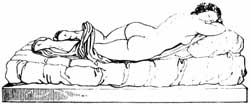Hermaphroditus

The name is compounded of Hermes and Aphrodite, and is synonymous with ἀνδρογύνης (androgynēs), γύνανδρος (gynandros), ἡμίανδρος (hēmiandros), etc. He was originally a male Aphrodite (Aphroditus), and represented as a Hermes with the phallus, the symbol of fertility,1 but afterwards as a divine being combining the two sexes, and usually with the head, breasts, and body of a female, but with the sexual parts of a man.
According to a tradition in Ovid,2 he was a son of Hermes and Aphrodite, and consequently a great-grandson of Atlas, whence he is called Atlantiades or Atlantius.3 He had inherited the beauty of both his parents, and was brought up by the nymphs of Mount Ida. In his fifteenth year he went to Caria; in the neighborhood of Halicarnassus he laid down by the well Salmacis. The nymph of the well fell in love with him, and tried to win his affections, but in vain. Once when he was bathing in the well, she embraced him, and prayed to the gods that they might permit her to remain united with him for ever. The gods granted the request, and the bodies of the youth and the nymph became united in such a manner that the two together could not be called either a man or a woman, but were both. Hermaphroditus, on becoming aware of the change, prayed that in future every one who bathed in the well should be metamorphosed into an hermaphrodite.4
In this, as in other mythological stories, we must not suppose that the idea is based on a fact, but the idea gave rise to the tale, and thus received, as it were, a concrete body. The idea itself was probably derived from the worship of nature in the East, where we find not only monstrous compounds of animals, but also that peculiar kind of dualism which manifests itself in the combination of the male and female. Others, however, conceive that the hermaphrodites were subjects of artistic representation rather than of religious worship.
The ancient artists frequently represented hermaphrodites, either in groups or separately, and either in a reclining or a standing attitude. The first celebrated statue of an hermaphrodite was that by Polycles.5
❧
Iconography
Old reliefs related to the cult of Dionysus sometimes show Hermaphroditus as a bacchante with a thyrsus staff. On Hellenic sculptures he is often shown in the nude. In Roman art Hermaphroditus is sometimes accompanied by a faun, engaged in lovemaking. He is shown on a fresco in the Casa di Olconio Rufo (Pompeii).
References
Notes
- Pausanias. Description of Greece i, 19.2.
- Metamorphoses iv, 285 ff.
- Ovid. Metamorphoses iv, 368; Hyginus. Fabulae, 271.
- Ovid, l.c.; Diodorus Siculus. Historical Library iv, 6; Lucian. Dialogues of the Gods, 15.2; Vitruvius. On Architecture ii, 8; Festus, s.v. Salmacis.
- Pliny the Elder. Naturalis Historia xxiv, 19, 20; comp. Heinrich. (1805). Commentatio qua Hermaphroditorum Artis antiquae Operibus insignium Origines et Causae explicantur. Hamburg; Welcker, in Creuzer and Daub's Studien, iv, p. 169 ff.
Sources
- Aken, Dr. A.R.A. van. (1961). Elseviers Mythologische Encyclopedie. Amsterdam: Elsevier.
- Smith, William. (1870). Dictionary of Greek and Roman Biography and Mythology. London: Taylor, Walton, and Maberly.
This article incorporates text from Dictionary of Greek and Roman Biography and Mythology (1870) by William Smith, which is in the public domain.